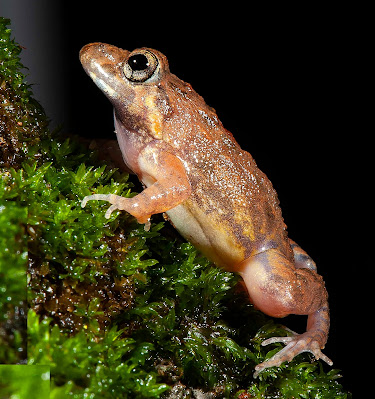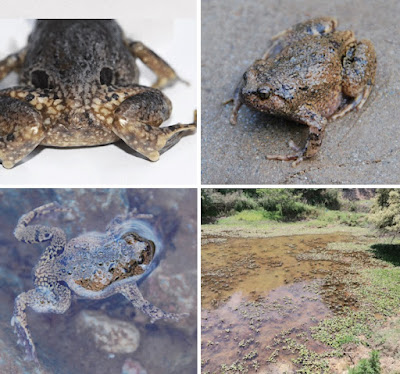[Most Recent Entries] [Calendar View]
Monday, August 2nd, 2021
| Time | Event | ||||
| 8:34a | [Herpetology • 2021] Minervarya pentali • DNA Barcoding and Systematic Review of Minervaryan Frogs (Dicroglossidae: Minervarya) of Peninsular India: Resolution of A Taxonomic Conundrum with Description of A New Species
Abstract The genus Minervarya is among the most widely distributed, commonly occurring, and taxonomically confusing groups of dicroglossid frogs in India. Recent studies have provided evidence that this genus contains complexes of morphologically conserved but genetically divergent taxa—some widely distributed across South and Southeast Asia, and many particularly restricted to the Western Ghats region of the Indian Peninsula—posing several challenges in resolving long-standing taxonomic confusions. Here, we present a systematic review of minervaryan species found in Peninsular India, based on extensive DNA barcoding with nearly 400 samples from the entire range of the genus, including 277 new samples and topotypic material for most available names from the study area, combined with detailed morphological studies. As a result, we recognise 18 species in Peninsular India, including a new species described herein as Minervarya pentali sp. nov. Due to the comprehensive nature of the study, including comparisons with all available types, certain long-standing taxonomic uncertainties on the status of ten previously known taxa are resolved. Rana (Tomopterna) parambikulamana Rao, 1937 (= Minervarya parambikulamana), Rana (Hylorana) sauriceps Rao, 1937 (= Minervarya sauriceps), and Fejervarya kudremukhensis Kuramoto, Joshy, Kurabayashi, and Sumida, 2008 “2007” (= Minervarya kudremukhensis), are considered as junior subjective synonyms of Rana (Rana) limnocharis mysorensis Rao, 1922 (= Minervarya mysorensis); Nyctibatrachus sanctipalustris var. modestus Rao, 1920 (= Minervarya modesta) is proposed to be a synonym of Rana limnocharis syhadrensis Annandale, 1919 (= Minervarya syhadrensis); while Rana murthii Pillai, 1979 (= Minervarya murthii) and Fejervarya mudduraja Kuramoto, Joshy, Kurabayashi, and Sumida, 2008 “2007” (= Minervarya mudduraja) are considered as junior subjective synonyms of Rana nilagirica Jerdon, 1853 (= Minervarya nilagirica). At the same time, Rana brevipalmata Peters, 1871 (= Minervarya brevipalmata), previously known only from its original description and the type specimen, is recognised as a distinct species referable to live populations in the Western Ghats. The study results in taxonomic stability of all the currently recognised members of the genus in Peninsular India. Significant geographical range extensions of species previously known from single localities are also provided based on morphologically and genetically confirmed records. Additionally, we classify all the recognised species into eight species-groups, with the aim of facilitating a better working taxonomy and future systematic studies on minervaryan frogs across their entire known range in Asia. Minervarya pentali sp. nov. Pental’s Minervaryan Frog Etymology: The species is named after Prof. Deepak Pental, a renowned Indian Plant Genetist and former Vice Chancellor of University of Delhi, in appreciation of his contributions to science. We also acknowledge his support and encouragement in setting-up of the Systematics La b at Department of Environmental Studies, University of Delhi. The species epithet pentali is treated as a noun in the genitive case. Sonali Garg and S. D. Biju. 2021. DNA Barcoding and Systematic Review of Minervaryan Frogs (Dicroglossidae: Minervarya) of Peninsular India: Resolution of A Taxonomic Conundrum with Description of A New Species. Asian Herpetological Research. 12(X): ... DOI: 10.16373/j.cnki.ahr.210023 | ||||
| 9:20a | [Herpetology • 2021] Glyphoglossus huadianensis • A New Species of Glyphoglossus Günther, 1869 (Anura: Microhylidae) from Western Yunnan, China
Abstract A new species of microhylid frog of the genus Glyphoglossus Günther, 1869 is described from Huadianba, Cangshan Mountain, Dali Bai Autonomous Prefecture, Yunnan Province, China. Glyphoglossus huadianensis, new species, is compared with congeners from China and other parts of Southeast Asia, and was distinguished from the others by the following combination of characters: adult male body size up to 37.8 mm; pupil rounded; supratympanic fold distinct; tympanum concealed; toe tips obtuse; subarticular tubercles prominent and rounded; foot webbing extensive; outer metatarsal tubercle present; dorsum tuberculate, yellowish-brown/earth-yellow; and a pair of conspicuous large round spots in groin. The new species is the tenth species of Glyphoglossus to be described, and the second known from China. Keywords: Glyphoglossus huadianensis sp. n.; taxonomy; morphology; China
Glyphoglossus huadianensis sp. n. Diagnosis: The new species of Glyphoglossus is medium-sized (average SVL 36.5 mm in adult males; body size of taxa of Glyphoglossus ranges from 26.9 ± 3.3 mm to 61.3 ± 0.7 mm; Table 4), and shares the following combination of characters with its congeners: flattened body; wide head; short snout; small eyes; maxillary and vomerine teeth present; paired dermal folds across palate; a crescentic, inner metatarsal tubercle present (Inger, 1966; Manthey and Grossmann, 1997; Parker 1934). The new species can be diagnosed from other congeners by the combination of the following characters: adult male body size larger than 34 mm (SVL range of 34.8–37.8 mm); pupil rounded; supratympanic fold distinct; tympanum concealed; toe tips obtuse; subarticular tubercles prominent and rounded; webbing between toes extensive, extending up to the second subarticular tubercle on toe IV; outer metatarsal tubercle present; dorsum tuberculate; and a pair of conspicuous large round spots in groin. Etymology: The name huadianensis refers to Huadianba, the locality where the new species was first found. Its Chinese common name is “huā diàn xiǎo xiá kǒu wā” ( 花甸小狭口蛙 ). Dongru Zhang, Shuo Liu, Lixia Zhang, Hong Hui, Heng Xiao and Dingqi Rao. 2021. A New Species of Glyphoglossus Günther, 1869 (Anura: Microhylidae) from Western Yunnan, China. Asian Herpetological Research. DOI: 10.16373/j.cnki.ahr.200106 |
| << Previous Day |
2021/08/02 [Calendar] |
Next Day >> |







